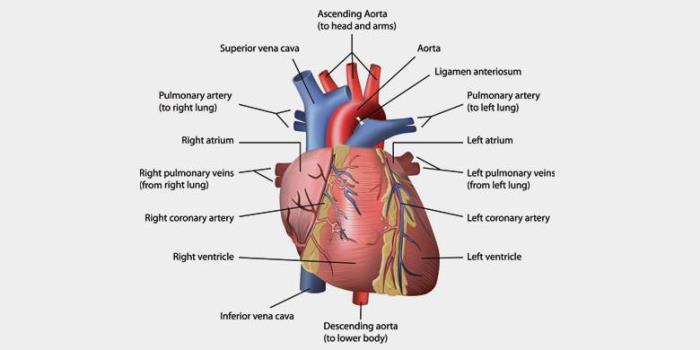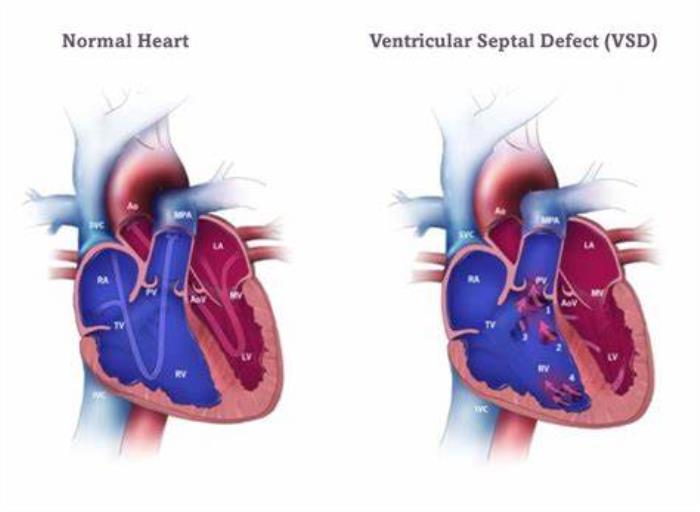Ventricular Septal Defect (VSD) is one of the most common congenital heart defects, characterized by a hole in the wall (septum) that separates the heart’s two lower chambers (ventricles). This opening allows oxygen-rich blood from the left ventricle to mix with oxygen-poor blood in the right ventricle, potentially leading to increased blood flow to the lungs and extra strain on the heart. Understanding VSD’s causes, risk factors, and its effects on the heart's function is essential for early detection and effective treatment.
What is a Ventricular Septal Defect? Overview of the Condition
A ventricular septal defect is a structural heart issue present at birth, resulting from an opening in the septum that divides the heart's ventricles. The size of this hole can vary from small to large, affecting the condition's severity and symptoms. Small VSDs might close on their own over time and cause few symptoms, while larger defects can result in complications, including heart failure and pulmonary hypertension. VSD can occur as an isolated defect or alongside other congenital heart conditions.
How the Heart Functions and Where VSD Fits In
The heart pumps blood through the body using four chambers: two atria and two ventricles. The right side of the heart pumps deoxygenated blood to the lungs, while the left side circulates oxygenated blood throughout the body. In a healthy heart, the septum keeps these oxygen-poor and oxygen-rich blood supplies separate. With VSD, this barrier is compromised, causing blood to flow from the left to the right ventricle, leading to excess blood in the lungs, increased workload on the heart, and reduced efficiency in circulating oxygen-rich blood.

Common Causes of Ventricular Septal Defect
While the exact cause of VSD is often unknown, it typically develops during early fetal heart formation. In some cases, VSD is an isolated defect, but it can also occur alongside other congenital heart anomalies. Genetic mutations, chromosomal abnormalities, or disruptions in the fetal development process can contribute to VSD. Although VSD is often congenital, it can also be acquired later in life due to conditions such as heart attacks, though this is rare.
Genetic Factors Contributing to VSD Development
Genetic predisposition plays a significant role in the development of VSD. Infants with chromosomal abnormalities, such as Down syndrome, are at a higher risk of being born with VSD or other heart defects. Certain inherited genetic mutations can increase the likelihood of VSD, and in families with a history of congenital heart defects, the risk of VSD may be higher in future generations. Genetic counseling and testing can help identify these risk factors during pregnancy.
Environmental Risk Factors During Pregnancy Linked to VSD
Exposure to certain environmental factors during pregnancy can raise the risk of a baby being born with VSD. These factors may include maternal exposure to certain medications, infections, or harmful substances like alcohol and tobacco. Conditions like poorly controlled diabetes in the mother are also linked to an increased risk of congenital heart defects, including VSD. Prenatal care, including the avoidance of teratogens, plays a critical role in reducing the risk of VSD and other congenital anomalies.
How Maternal Health Influences the Risk of VSD in Infants
The overall health of the mother during pregnancy can significantly impact the baby's heart development. Poorly managed maternal health conditions, such as diabetes, obesity, and infections, have been associated with a higher risk of VSD. Maternal age is also a factor, as pregnancies in women over 35 may present a greater risk for congenital heart defects. Maintaining good health and receiving appropriate prenatal care can reduce some of these risks, supporting healthy fetal heart development.
Types of Ventricular Septal Defects and Their Causes
Ventricular septal defects (VSDs) are categorized based on their location and size within the ventricular septum, the wall that separates the heart's two lower chambers. Types include perimembranous, muscular, inlet, and outlet VSDs, each associated with different parts of the septum. VSDs are generally congenital, arising from incomplete septal development during fetal growth, but they can also occur as a result of a heart attack or other cardiac conditions in adults.
Symptoms of VSD in Infants and Children: Early Warning Signs
In infants and children, early signs of VSD include rapid breathing, difficulty feeding, fatigue, and poor weight gain. Larger defects may cause increased heart rate and respiratory infections, as the body struggles to circulate oxygenated blood. Recognizing these symptoms early is crucial for timely diagnosis and treatment, potentially preventing complications later.
Recognizing Symptoms of VSD in Teenagers and Adults
For teenagers and adults, symptoms may include shortness of breath during activity, fatigue, irregular heartbeats, and in severe cases, cyanosis (bluish skin from low oxygen levels). Adults with VSD may experience these symptoms if the defect was undiagnosed earlier or if a previously small defect has worsened over time.

How VSD Affects Heart and Lung Function
VSDs allow oxygen-rich blood to flow from the left to the right ventricle, leading to increased blood flow to the lungs. This can result in pulmonary hypertension, increased workload on the left side of the heart, and eventual heart failure if left untreated. Over time, VSD can significantly impact both heart and lung function, stressing the cardiovascular system.
Common Signs of VSD Complications: When to Seek Help
Complications from untreated or severe VSDs include pulmonary hypertension, arrhythmias, endocarditis (infection of the heart lining), and heart failure. Warning signs, such as rapid breathing, fatigue, blue-tinted lips or nails, and recurrent respiratory infections, signal the need for immediate medical evaluation and possible intervention.
Differences in Symptoms Between Small and Large VSDs
The size of the defect influences symptoms and severity. Small VSDs may be asymptomatic or cause only mild issues, while large VSDs can result in more pronounced symptoms such as labored breathing, feeding difficulties in infants, and frequent respiratory infections. Large VSDs also increase the risk of complications like heart failure and pulmonary hypertension.
The Role of Physical Activity in Triggering VSD Symptoms
Physical activity can exacerbate VSD symptoms, particularly in children and adults with larger defects. Activities that increase heart rate may lead to shortness of breath, fatigue, and dizziness due to the heart’s inability to pump efficiently. For individuals with significant VSDs, physical exertion can place additional stress on the cardiovascular system, sometimes prompting a reevaluation of treatment needs.
Diagnostic Tests to Identify VSD Causes and Symptoms
Diagnosis typically involves echocardiography, which provides images of the heart’s structure and function, revealing the presence, size, and location of the VSD. Additional tests, such as an electrocardiogram (ECG), chest X-rays, or cardiac MRI, may also be used to assess heart function and evaluate any lung involvement, guiding the treatment approach.
How Symptoms of VSD May Progress Over Time
VSD symptoms may worsen with age, especially if the defect is large or left untreated. Progressive symptoms, such as worsening shortness of breath, frequent respiratory infections, and decreased activity tolerance, may indicate increased strain on the heart and lungs. Regular monitoring is essential to catch any progression early and adjust treatment as needed.
Monitoring VSD Symptoms in Infants: What Parents Should Know
Parents should monitor infants with VSD for signs like rapid breathing, difficulty feeding, sweating during feeding, and poor weight gain. Any noticeable changes in breathing patterns or feeding habits should be promptly discussed with a pediatric cardiologist, as these could indicate worsening of the condition or a need for medical intervention.
Treatment Considerations Based on VSD Causes and Symptoms
Treatment depends on the size, location, and impact of the VSD. Small, asymptomatic defects often require only regular monitoring, while larger or symptomatic VSDs may need medical management or surgical repair. Medications may be used to manage symptoms, while surgical options include patch closure, catheter-based repair, or open-heart surgery for severe cases.
Potential Long-Term Effects of Untreated Ventricular Septal Defect
If left untreated, a significant VSD can lead to complications like pulmonary hypertension, right heart enlargement, heart failure, and arrhythmias. In severe cases, Eisenmenger syndrome, a form of irreversible pulmonary hypertension, can develop, greatly limiting treatment options. Early detection and management are essential to prevent these outcomes.
Conclusion: Managing VSD with Early Detection and Care
Early detection and ongoing care are crucial for managing VSD and preventing complications. Regular checkups, appropriate treatment, and monitoring ensure that those with VSD can lead healthier lives with fewer risks. For many, timely interventions can effectively control symptoms, promoting better long-term heart and lung health.
Best VSD Surgery in India
The Best VSD Surgery in India offers effective treatment for ventricular septal defects, helping improve heart function and quality of life for patients with congenital heart defects.
Best VSD Surgery Hospitals in India
The best vsd surgery hospitals in india are equipped with advanced cardiac care facilities and specialized pediatric teams, providing comprehensive care from diagnosis through recovery.
VSD Surgery Cost in India
The vsd surgery cost in india is affordable and transparent, offering high-quality care and accessible options for patients at leading hospitals.
Best VSD Surgeons in India
The Best VSD Surgeons in India are experts in congenital heart defect repairs, providing precise and compassionate care tailored to each patient’s unique needs.
FAQ
What causes ventricular septal defect?
VSDs are often congenital, resulting from incomplete formation of the heart’s ventricular septum during fetal development. In rare cases, they can occur in adults following a heart attack or trauma.
Are ventricular septal defects hereditary?
Some VSDs may have a genetic component, especially when associated with other congenital syndromes, but they are not typically inherited directly.
What are the common symptoms of VSD in infants and children?
Symptoms include rapid breathing, poor feeding, fatigue, slow weight gain, and frequent respiratory infections, especially in larger VSDs.
Can VSD symptoms appear later in life?
Yes, VSD symptoms may appear later in life if a previously small defect enlarges or if a new defect forms due to other cardiac conditions.
How serious is a ventricular septal defect if left untreated?
Untreated large VSDs can lead to complications such as heart failure, pulmonary hypertension, and arrhythmias, significantly impacting heart and lung health.